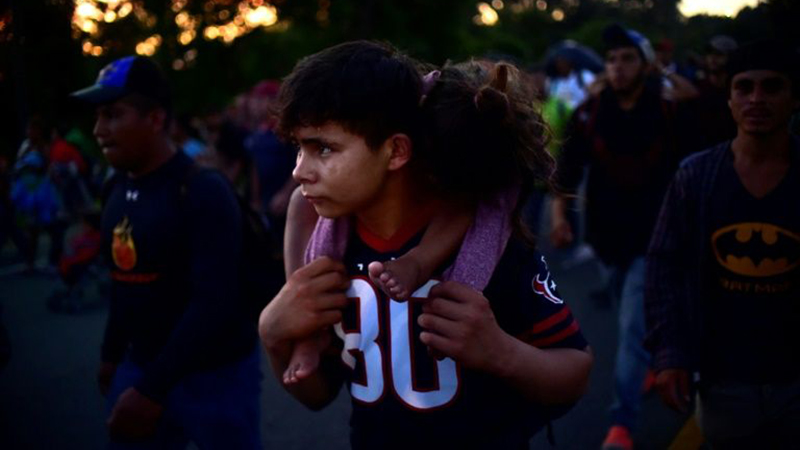The United States has cut hundreds of millions of dollars in aid designated for Guatemala, Honduras, and El Salvador until their governments address the migrant crisis, but experts say this may not be the answer to stopping the influx of people at the southern border.
On Monday afternoon, the State Department announced that it would be stopping aid to the three countries until they made “concrete actions to reduce the number of illegal migrants coming to the U.S. border.”
Last month, 144,000 undocumented immigrants crossed the southern border, the highest monthly total in 13 years and the third month in a row where over 100,000 people have illegally tried to enter the U.S. The Northern Triangle countries of Guatemala, Honduras, and El Salvador have been the primary source of these migrants, despite receiving large amounts of aid from the U.S. annually.
The aid packages are meant to be used to treat the root cause of migration through building infrastructure, education programs, and police training. And cutting aid to these Central American countries may not be the answer to stopping migrants coming to the U.S.
In 2014, the Obama administration ramped up its aid allocation to Central America because they identified that it was within America’s interest to promote prosperity, improve governance and enhance security within the region. Under the program, “U.S. Programs and Engagement Promote a Prosperous, Secure, and Well-Governed Central America,” the U.S gave $338.1 million in aid to the area in Fiscal Year 2014, which increased to $753.7 million in Fiscal Year 2016. But since then the aid package has been decreasing yearly and in Fiscal Year 2018, the region received $615 million.
Since March, the Trump administration has been pushing to cut all aid to the region because of the increase of migrants to the U.S. However, research has shown that aid money has helped stabilize the Northern Triangle and cutting that aid off could exacerbate the illegal immigration problem.
VIDEO: Authorities on Mexico's southern border with Guatemala detain undocumented Central American migrants hoping to reach the US, amid speculation about the contents of Mexico's deal to curb migration in order to avert President Donald Trump's threat of tariffs pic.twitter.com/dDMc7LdsOY
— AFP News Agency (@AFP) June 11, 2019
Why Has Migration to the U.S. Increased Despite Aid?
The aid that the Northern Triangle has received in the past has been to address the source of migration, the two main being the economy and violence.
The economy plays an important role in migration because of the large inequalities in wealth and opportunity between the U.S., Mexico, and Central America. Until these inequalities are addressed, which will take time, people are going to continue to move to the country that holds the most wealth, Ariel Ruiz Soto, an Associate Policy Analyst at the Migration Policy Institute, told The Globe Post.
Many people fleeing the Northern Triangle live in poverty. According to the World Bank, 29 percent of Salvadorians, 49 percent of Guatemalans, and 53 percent of Hondurans live on less than $5.50 a day.
However, the recent spike in migration seen in the last couple of years is caused by the increased coverage and pressure by the current administration to put a stop to all migration, said Soto.
“The increased focus by the U.S. to make visible migration in the region, that has led to this fear that migration will become harder to get to the country, therefore more people are trying to come in before something happens,” said Soto.
Violence in the region is one of the key drivers of emigration from Central America. A report by the Congressional Research Service, U.S. Strategy for Engagement in Central America: Policy Issues for Congress, stated that many factors contribute to the high crime rates such as poor security, fragmented families, and lack of legitimate employment opportunities.
Christopher Boian, the senior communications officer at the United Nations High Commissioner for Refugees, said that often people leaving Central America are fearing for their safety.
“There are people, women, children, men, often moving as entire families, who really are running for their lives and who are fleeing to escape the violence and the persecution that has become endemic to certain areas in Central America,” he told The Globe Post.
But under the U.S Strategy for Engagement aid money was allocated towards professionalizing law enforcement and enhancing police engagement with civil society to try and combat violence. Although violence is still prevalent throughout Central America, there has been some success in cutting down crime rates. In El Salvador, the homicide rate dropped 42 percent between 2015 and 2017. Now that aid for these programs has been cut it could lead to even higher numbers of people fleeing Central America to seek asylum in the U.S.
Also, Soto said it’s important to realize that assistance to Central American countries will increase immigration in the short term. When countries have a more stable economy people will be able to afford to make the journey to the U.S.. He said the migration is not always a bad thing and is often a sign of development in these countries. Once immigrant families get established in the U.S. and are able to send money back to their families in Central America, he said the flow of migrants may level out.
“The focus is on short-term goals not long-term objectives and so that’s why we won’t see a decrease in migration, even in the best conditions, in a year or two years, it could take five years, 10 years,” said Soto.
Cutting desperately needed aid to Central American countries will exacerbate the harms people are fleeing.
This wrongheaded decision will only make it more likely people will be forced to leave their homes. https://t.co/Y75Z5Zflb4
— Amnesty International USA (@amnestyusa) June 18, 2019
How Aid Could Be Improved
Cutting aid is not the answer when it comes to stopping the flow of migrants to the U.S despite what the current administration believes. Instead, it is a matter of better targeting and tracking aid, said Soto.
Programs that prioritize women, children, and economic growth such as education for farmers have had success in each country, he said.
“We know that programs that are most effective are programs that work with youth, programs that work with children or with 16 and 15-year-olds to try to keep them from joining gangs. We know that programs that prioritize health for women in the countries of origin,” said Soto. “All those initiatives have proved helpful.”
Also, while the U.S. is a key aid provider to Central America they are not the main source of development funding in the Northern Triangle. Guatemala, Honduras, and El Salvador created the Alliance of Prosperity in the Northern Triangle, which aims to tackle the root causes of emigration such as public safety and education. The three countries allocated around $7.2 billion for the initiative between 2016 and 2018. Soto said that it is important that U.S. aid works in conjunction with the programs that are already in place to get the best outcome for Central America and the U.S.
Soto emphasized that aid and development are not a quick fix to stop migration to the U.S., instead, it will take years for aid to truly work in these countries and stabilize them to a point where people no longer need to migrate from them.
“The aid hasn’t fully worked because it hasn’t been fully given, the aid hasn’t worked because it hasn’t been really targeted and because there are no mechanisms for evaluation and if we were to address those and be committed over the long term, then we would begin to see some changes that would begin to reduce migration in the long term,” said Soto.
However, although it is a general consensus by experts that U.S. aid would help contribute to solving the issues in Central America that lead to migration, there has been no established limit to how much funding it would take to stop the influx of immigrants to America.
President Donald Trump has decided to stop financial aid to Honduras, Guatemala and El Salvador. He believes that the three Central American countries have not been doing enough to stem the flow of illegal migrants into the US. https://t.co/6aozhJ3KQK pic.twitter.com/uT1yo8Mumr
— Financial Times (@FinancialTimes) June 17, 2019
Other Aid Benefits
The disbursement of aid is not only to stop the migration problem it also helps to stabilize the economy and create a better trade relationship between the U.S. and the Northern Triangle. Since the implementation of the Central America Free Trade Agreement, the U.S. and Central America have considerably integrated their trade. In 2017 Guatemala, Honduras, and El Salvador imported $27 billion of U.S. goods.
“Canada, the U.S., Mexico, and Northern Central America are regions that are entangled in multiple different ways,” said Soto. “Prosperity in the three countries in Central America is prosperity for Mexico and for the United States.”
Mexico Asks UN for More Support to Tackle Central American Migrants





















